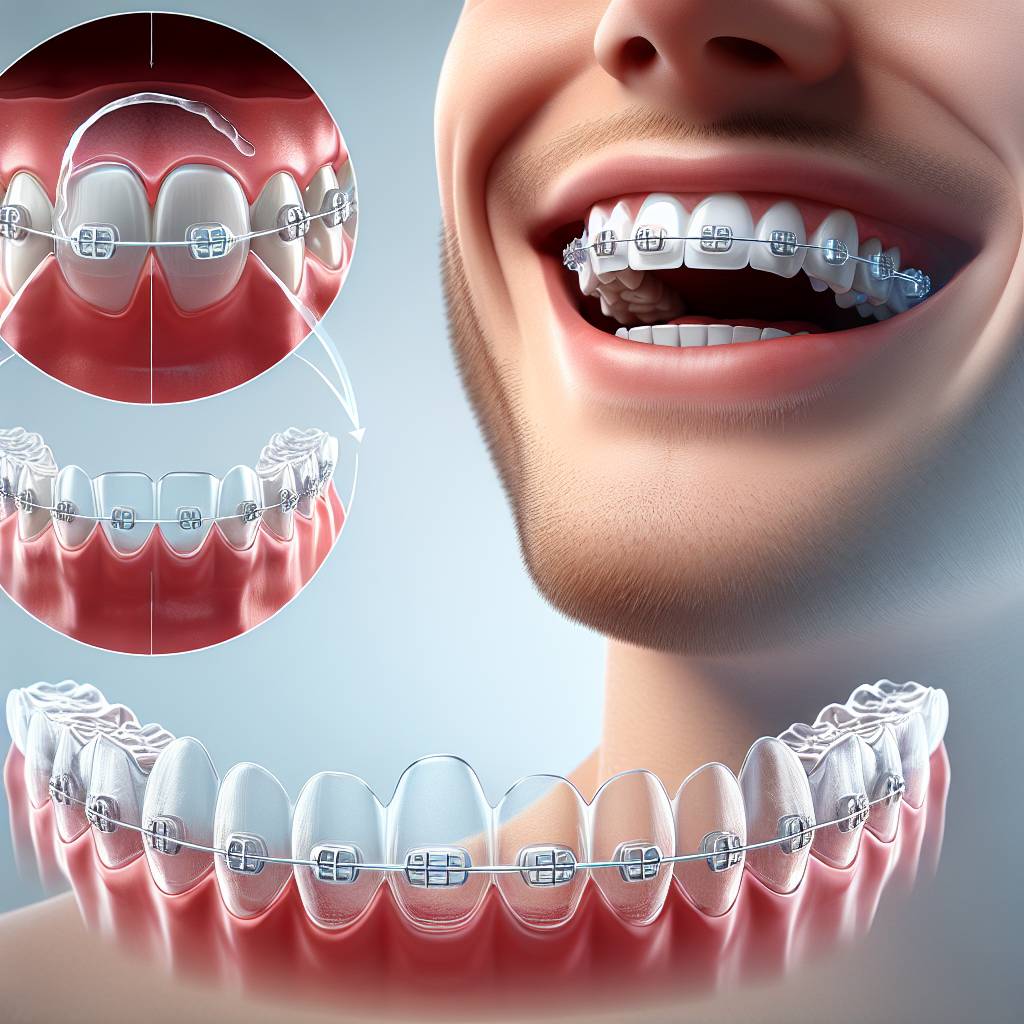Invisalign is a modern orthodontic treatment used to straighten teeth without the use of metal braces. This treatment utilizes custom-made, clear aligners to gradually move teeth into the desired position. The length of time needed to straighten teeth with Invisalign depends on the severity of the misalignment and the patient’s commitment to wearing their aligners as prescribed. On average, most patients can expect to wear their Invisalign aligners for up to 12 months.Invisalign is an orthodontic treatment used to straighten teeth without the use of traditional metal braces. It uses a series of clear, custom-made removable aligners that are designed to fit over your teeth. Each aligner is worn for two weeks and gradually moves your teeth into the desired position. As you replace each aligner with the next in the series, your teeth will continue to move until they reach the final position prescribed by your orthodontist.
The Benefits of Invisalign
Invisalign is a popular alternative to traditional metal braces, offering many advantages. It is a comfortable, convenient and virtually invisible way to straighten teeth, and it can help you achieve a beautiful smile in less time than it would take with traditional braces. Here are some of the benefits of Invisalign:
Invisalign aligners are made from a smooth, comfortable plastic material that won’t irritate your gums or cheeks like metal braces can. They also don’t require elastic bands or metal wires, so they are easier to keep clean and maintain. The aligners are removable too, which means that you can brush and floss normally without the hassle of working around brackets and wires.
In addition to being more comfortable than traditional metal braces, Invisalign is also much more discreet. The clear aligners are virtually invisible when worn, so you can go about your daily life without feeling self-conscious about having braces on your teeth.
Finally, Invisalign treatment typically takes less time than traditional braces. Patients can usually see results within six months to one year with Invisalign compared to two years or more with conventional braces. This makes it an ideal choice for busy adults who don’t have the time for long-term orthodontic treatment.
Invisalign provides a number of advantages over traditional metal braces, making it an attractive option for many patients who want to straighten their teeth without having to wear unsightly metal hardware on their teeth for extended periods of time. With its comfort, convenience and faster treatment times, Invisalign is quickly becoming one of the most popular options for orthodontic treatment today.
Types of Invisalign Aligners
Invisalign aligners are a great option for those looking to straighten their teeth without the hassle of traditional metal braces. There are several different types of Invisalign aligners available, each with its own unique benefits and features. The most popular types of Invisalign aligners include:
Clear Aligners: Clear aligners are the most popular type of Invisalign aligner and feature removable, transparent trays that fit over your teeth. These trays can be removed for eating and brushing and must be worn for at least 22 hours per day in order to be effective.
Vivera Retainers: Vivera retainers are a type of Invisalign aligner designed to help keep your teeth in place after undergoing Invisalign treatment. These retainers come in two varieties: standard retainers and advanced retainers. Standard retainers help to maintain the alignment achieved through treatment while advanced retainers have additional features such as tooth whitening or fluoride treatments built into them.
Elastics: Elastics are small rubber bands that attach to your clear aligner trays and help move your teeth into their desired position more quickly than clear aligner trays alone can do. Elastics come in a variety of sizes, colors, and strengths, so it’s important to talk to your orthodontist about which ones will work best for you.
Essix Retainers: Essix retainers are similar to Vivera retainers in that they help keep your teeth in place after undergoing Invisalign treatment. Unlike Vivera retainers though, Essix retainers are made from a thin plastic material rather than metal wires or brackets, making them more comfortable to wear and easier to adjust if needed.
No matter which type of Invisalign aligner you choose, it’s important that you follow all instructions provided by your orthodontist for optimal results. With proper care and maintenance, you can enjoy a beautiful new smile with these convenient alternatives to traditional metal braces!
How Long Does Treatment Take With Invisalign?
Invisalign treatment typically takes between 6 and 18 months to complete, although this can vary depending on the complexity of your case. Your Invisalign provider will be able to give you a more accurate timeline for your individual situation. The length of treatment is also affected by how often you wear your aligners and how often you come for check-ups. Generally, the more compliant you are with wearing your aligners, the shorter the treatment time.
The amount of time it takes to move through each set of aligners also varies from person to person. You will be given a new set of aligners approximately every two weeks or so, but depending on how much movement is needed, this can range from one week to six weeks between aligner sets. Again, your Invisalign provider will be able to provide a better idea of what you can expect when it comes to the frequency and length of each stage of treatment.
If you need faster results, ask your Invisalign provider about Accelerated Treatment options such as Propel and AcceleDent that can help move teeth faster than usual. However, these treatments are not suitable for everyone and may carry additional costs. Ask your Invisalign provider if Accelerated Treatment is right for you.
How Long Does Invisalign Take to Straighten Teeth?
Invisalign is a clear dental appliance used to straighten teeth. It is a popular choice among adults, teens, and children because it is comfortable and virtually invisible. The length of time it takes to straighten teeth with Invisalign depends on several factors, including the severity of the misalignment, the patient’s compliance with wearing the aligners, and the individual’s age. Generally speaking, patients can expect to have their teeth straightened in 6-18 months using Invisalign.
The severity of the misalignment determines how long it will take to straighten teeth with Invisalign. If a patient has minor misalignment or crowding, then they may only need 6-12 months of treatment. On the other hand, if a patient has more severe misalignment or crowding, then they may need up to 18 months of treatment.
Patients must be compliant with wearing their aligners in order for treatment to be successful and for it to take as little time as possible. Patients should wear their aligners for at least 22 hours per day in order to achieve optimal results in the shortest amount of time possible.
Age also factors into how long it will take to straighten teeth with Invisalign. Younger patients tend to respond better than older patients because their bones are still growing and developing which makes them more malleable and easier to move into place than older bones that are set in place. This means that younger patients can achieve straighter teeth faster than older patients can.
Ultimately, how long it takes to straighten your teeth with Invisalign depends on several factors, including the severity of misalignment, patient compliance with wearing their aligners, and age of the patient. Generally speaking, you can expect treatment times between 6-18 months depending on these factors.

Are There Any Alternatives to Invisalign?
Invisalign is a popular option for straightening teeth. However, there are alternatives to Invisalign that may be better suited for certain individuals. Braces are one of the most common alternatives to Invisalign. Braces involve the use of metal wires and brackets that are secured to the teeth and tightened over time, gradually shifting the teeth into alignment. Braces may be more convenient for some individuals, as they do not need to be removed like Invisalign aligners do.
Another option is lingual braces. Lingual braces are similar to traditional braces in that they involve metal brackets and wires, but they are placed on the back of the teeth instead of the front. This makes them less visible than traditional braces, making them a good option for those who want an orthodontic solution that is less noticeable.
Clear or ceramic braces are another alternative to Invisalign. These braces use brackets and wires just like traditional braces, but in a clear or tooth-colored material that blends in with the natural color of your teeth. This makes them less visible than traditional metal braces and more aesthetically pleasing than lingual braces, making them a great option if you want your orthodontic treatment to be subtle and discreet.
Finally, there are retainers which can help maintain the alignment achieved by other orthodontic treatments such as Invisalign and braces. Retainers can help keep your teeth in their new position once your orthodontic treatment has been completed, preventing them from shifting back out of alignment over time.
Overall, there are many alternatives to Invisalign available depending on your individual needs and preferences when it comes to straightening your teeth. Braces, lingual braces, clear or ceramic braces, and retainers are all viable options when it comes to achieving a straight smile without using Invisalign aligners.
Does Insurance Cover Invisalign?
Invisalign is an orthodontic treatment that uses a series of clear, custom-made aligners to gradually and discreetly straighten teeth. Invisalign is becoming more popular due to its cosmetic benefits and convenience. Many people are wondering if their insurance will cover the cost of this treatment.
The answer to this question depends on the insurance policy you have. Some insurers do offer coverage for Invisalign, but it is typically only available as part of an Orthodontic plan or under a Dental plan with orthodontic benefits. It’s important to remember that not all plans are the same and coverage can vary from policy to policy.
If you have an Orthodontic plan, you may be eligible for coverage for Invisalign up to a certain amount. Typically, insurers will cover up to 50% of the cost of the treatment, but this can vary depending on your plan. It’s important to read the details of your plan so you know exactly what is covered and what isn’t.
If your insurance doesn’t offer coverage for Invisalign, there are other options available. Many orthodontists offer payment plans or discounted rates for those who don’t have insurance coverage or who don’t want to use their insurance for the treatment. Additionally, some employers offer dental plans that include orthodontic coverage and may be worth looking into if you’re interested in getting Invisalign but don’t currently have coverage.
Ultimately, whether or not your insurance covers Invisalign depends on your individual policy and what type of coverage it provides. It’s important to read through your policy carefully so you know what type of coverage is available and what costs may be involved in getting Invisalign treatment.
Cost of Invisalign
Invisalign is an increasingly popular orthodontic treatment. It is a modern approach to straightening teeth, and many people prefer it due to its aesthetic appeal. However, before getting Invisalign, it is important to understand the cost associated with it.
The cost of Invisalign will vary depending on the severity of your case. Generally speaking, the average cost for treatment can range from $3,500 to $8,000. This cost includes all aligners needed throughout the treatment process as well as regular check-ups with your orthodontist.
In some cases, insurance may cover part or all of the cost of Invisalign treatment. If you have insurance, it is important to check with your provider to see what coverage you may have for this type of procedure. Additionally, many orthodontists offer financing options that can help make the cost more manageable for those who need it.
It is important to keep in mind that while Invisalign can be expensive up front, it may be worth considering due to its aesthetic appeal and convenience compared to traditional braces. Ultimately, only you can decide which option is best for you and if Invisalign fits into your budget.

Conclusion
In summary, Invisalign is a great way to straighten your teeth. The process can take anywhere from 6 to 24 months, depending on the severity of your teeth misalignment and how closely you follow your dentist’s instructions. You will need to wear the aligners for 22 hours a day, and you will need regular check-ups with your dentist. Invisalign is a safe and effective way to align your teeth without the use of traditional brackets and wires. It is also an affordable option for many people, as it does not require costly orthodontic work or surgery. With proper care and maintenance, you can enjoy a beautiful smile in no time!
Remember that everyone’s teeth alignment journey is different, so it’s important to consult with your dentist before making any decisions about treatment. Teeth straightening with Invisalign can be a long process but the results are well worth it! If you are considering Invisalign for yourself or someone else, make sure to do your research and ask plenty of questions about the process before taking the plunge.

